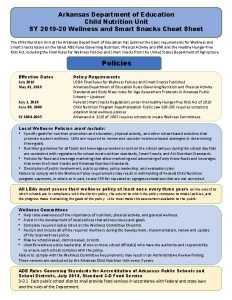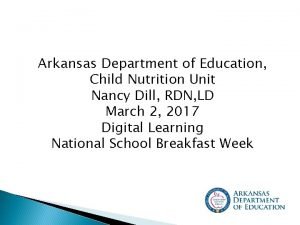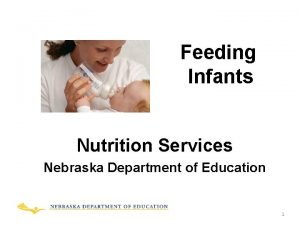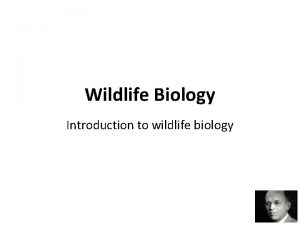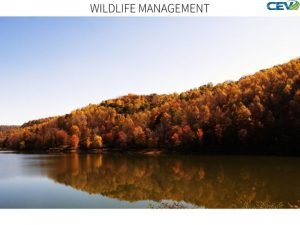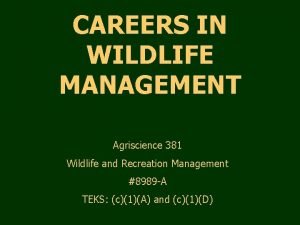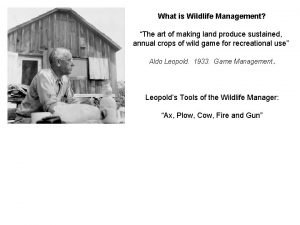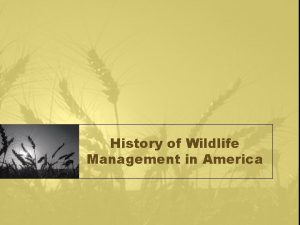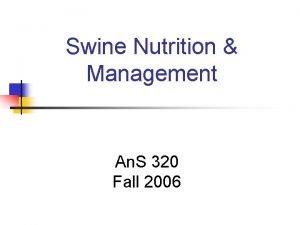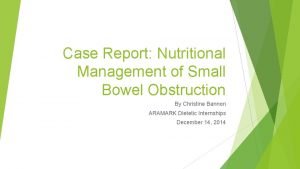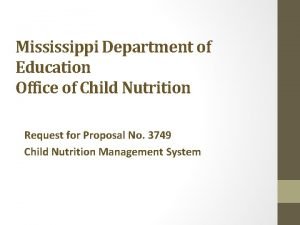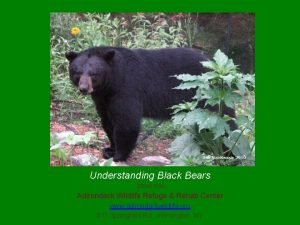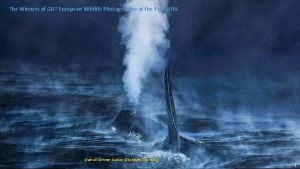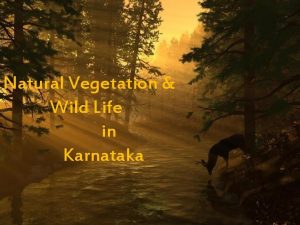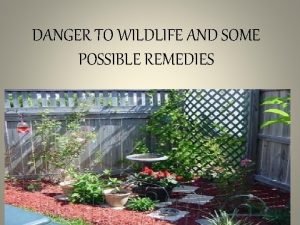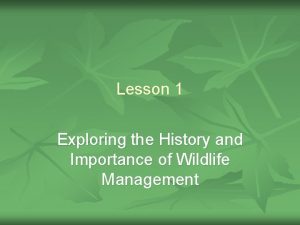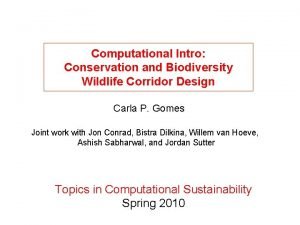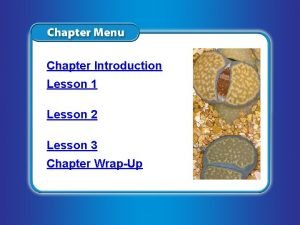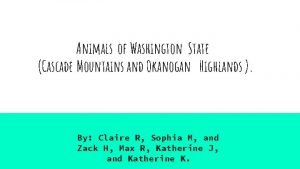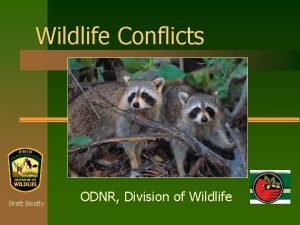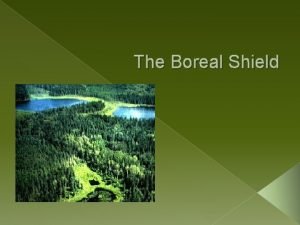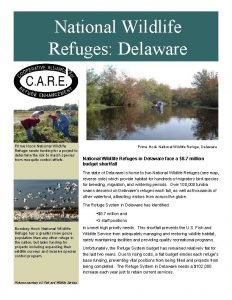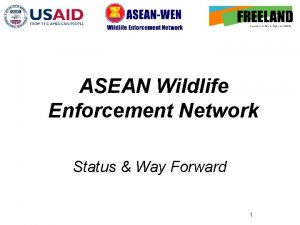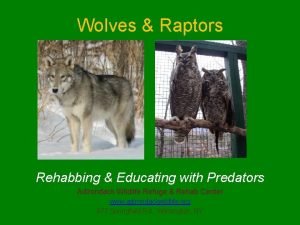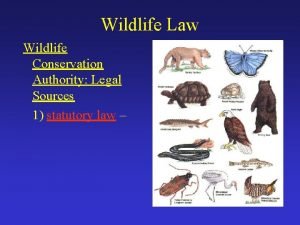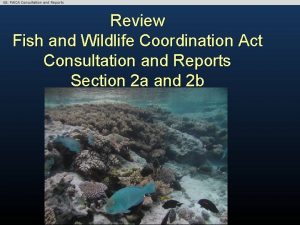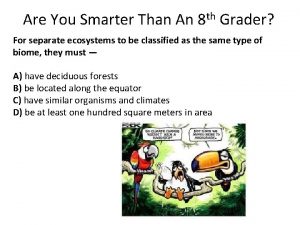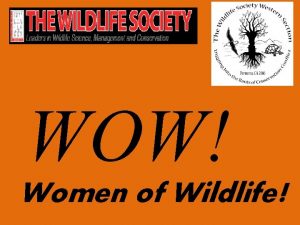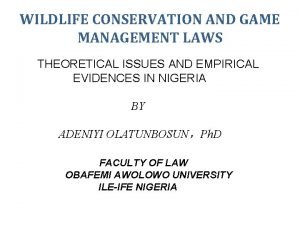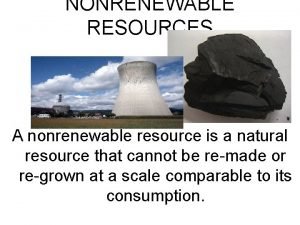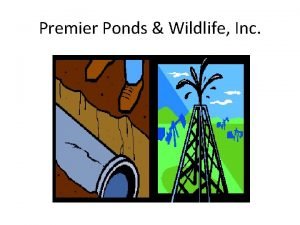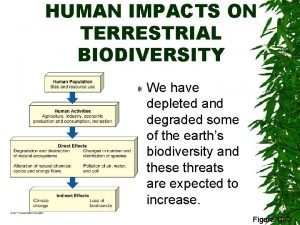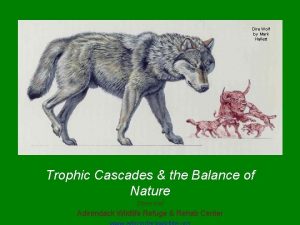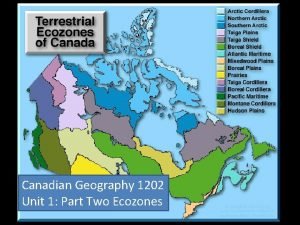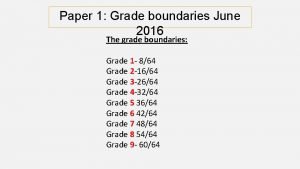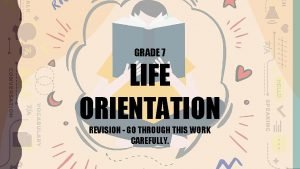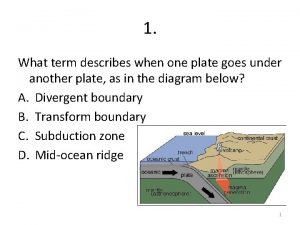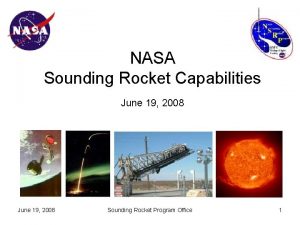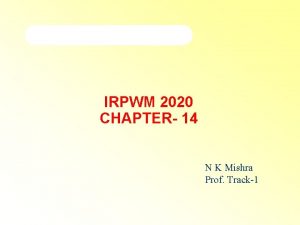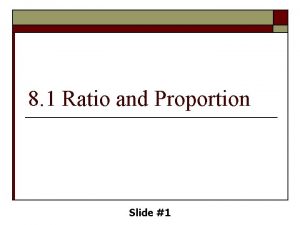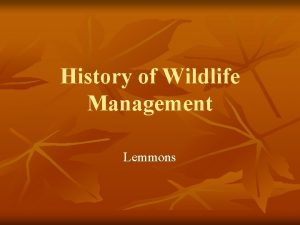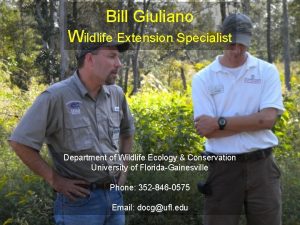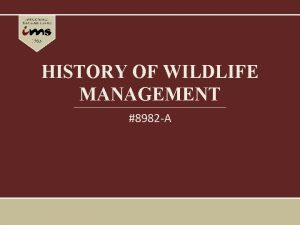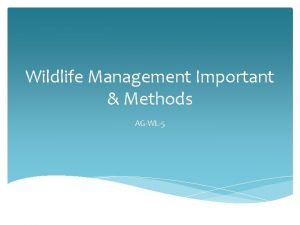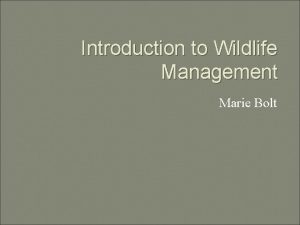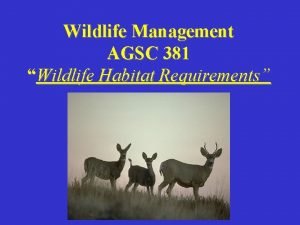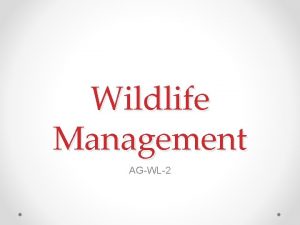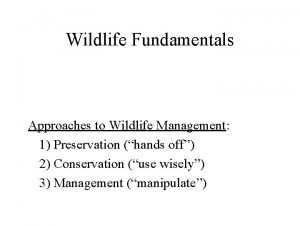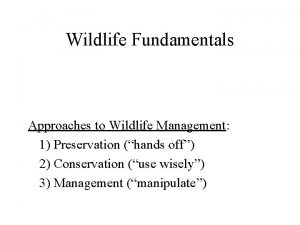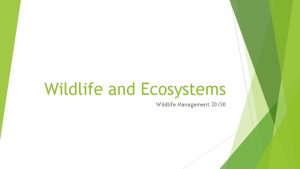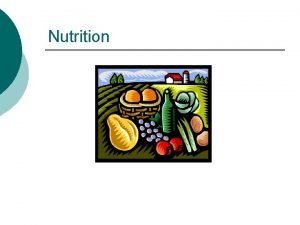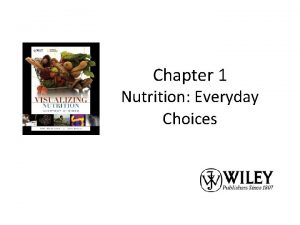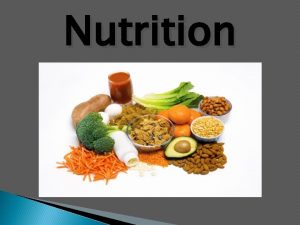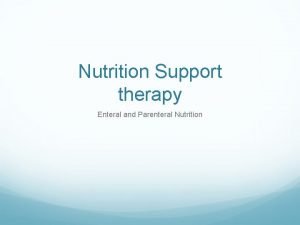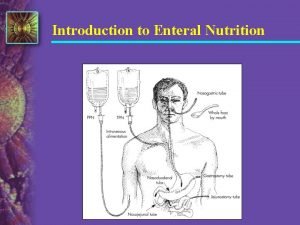Wildlife Nutrition March June 2012 WILDLIFE MANAGEMENT DEPARTMENT












































































- Slides: 76

Wildlife Nutrition March – June 2012 WILDLIFE MANAGEMENT DEPARTMENT SOKOINE UNIVERSITY OF AGRICULTURE MOROGORO

Topics to be Cover. . . Ø Introduction: Essence of Wildlife Nutrition Ø Feeding Habits Ø Types of feeding Ø Nutrient requirement Ø In-the-Field Demonstrations Ø Conclusion

Preamble…. . Many health, reproductive and production problems can be prevented with good nutrition. Ø Ø Ø Poor nutrition results in: Poor conception rates Lower calf crop Poor weaning weights Difficult births More infectious disease due to decreased immune system protection .

Preamble cont’d There are only two sources where an animal can obtain energy. 1. One is from the food it ingests. 2. The other is from the energy stored in its body in the form of fat. A lot of research has gone into the development of feeds that give animals exactly what they need to remain healthy and to perform at their peak. (unfortunately most done in domestic animals or captivity) As animals grow and mature, their nutritional needs change. ØYounger animals need diets high in protein. ØAs the animal matures, the animal needs a diet higher in carbohydrates. ØBreeding animal's nutritional needs change according ly

Preamble cont’d • Therefore: ØAnimals eat to acquire specific chemicals and energy. ØIntake determines level of productivity Productivity stage Nutritional Requirements • Calving to breeding • Breeding to weaning • Mid Gestation • Late Gestation • Highest • Moderate • Lowest • High

What exactly is Wildlife Nutrition? • Nutrition includes the following processes: 1. Acquisition (ingestion of external energy) 2. processing (digestion involving enzymatic hydrolysis) 3. Absorption (acquiring/assimilation of external energy) 4. Elimination (excess materials elimination) • This is to satisfy 3 essential needs of the body: – chemical energy necessary for work – raw materials for biosynthesis (enzymatic processes) – essential nutrients • The ingested matter must contain essential nutrients – nutrients in assembled form, vary according to type of animal

Factors determining food to be taken by wildlife üDiet selection in wild animals is driven by the quantity and quality of food available ØWhat foods are eaten is determined by a number of factors, among which are: 1. what is present, 2. what is available (food items may be present but not located in a usable location), 3. what is needed physiologically by the consumer, and 4. the habits of the species, including skills in locating food items

Classification feeding modes Depending on their food habits, wildlife are classified as Carnivorous (eat meat) animal matter is nutritionally complete and easy to digest Herbivorous (eat only plants) controlled by (quantity) or by a shortage of nutritious foods (quality). Omnivorous (eat a variety of plant and animal food items).

Ranking of Wildlife Foods (herbivores) 1. Preferred - utilized first and for as long as they remain available; generally are nutritious. 2. Staple - will maintain body weight and are highly nutritious, usually 2 nd choice. 3. Emergency - foods eaten to meet short-term nutritional needs, usually when staple foods are absent. 4. Stuffers - foods with low nutritional value that are consumed because there is nothing else to eat.

Lack of food= Starvation or Malnutrition • Starvation - animal dies from lack of food • Malnutrition - animal usually survives in poor condition due to lack of quality food – lower body weights, delayed maturity, lower reproductive rate, susceptible to disease/predation & extreme weather • In the Tanzania, rarely starvation but poor habitat results in malnutrition, especially during dry spell

Is understanding wildlife nutrition & feeding habits so important? • Determines health (quality) & abundance of animals • Ensures growth, reproduction & survival • Better chance of reaching genetic potential • Understanding & providing nutritional needs through habitat management

Additionally, , , Food selection and foraging can explain other observations, such as habitat use and movements. Body composition, blood and urine chemistry, and reproductive data are all potential indices to habitat quality. Nutritional parameters e. g. body condition provide ways to assess habitat quality. Food is something that can be manipulated to alter the distribution or productivity of animal populations. Nutrients, provide quantifiable (measurable) limits within which an animal and a population must operate. Body composition, blood and urine chemistry, and reproductive data are all potential indices to habitat quality.

3 Ways to Provide Wildlife Food. . . 1. Protect High-Valued Native Plants 2. Enhance Native Plants 3. Supplemental Plantings

What to do in case of wildlife food shortages Ø Supplemental feeding of wildlife often is not economically feasible nor biologically desirable. Management efforts should concentrate on providing appropriate natural foods in sufficient quantities where they can be utilized. In most cases, managing existing native plants is a more practical and costeffective method of enhancing wildlife habitat.

In Summary Ø To be effective, wildlife managers should understanding food habits and nutritional needs of various species. Ø Most nutritional needs of wildlife can be met through habitat improvement practices. Ø As is the case for wildlife treatment for diseases, in any circumstances, never provide food to wildlife

Nutrient Occurrence Ø Food originates from plant through Photosynthesis (source is solar energy). Ø Plants trap sunlight to synthesise complex materials (Energy). Light 6 CO 2 + 6 H 2 O → 2 C 3 H 6 O 3 + 6 O 2 Ø The energy is stored by the plants, as source of animals food.

Nutrients for Wildlife • Protein - body growth, development & maintenance • Carbohydrates - quick source of energy • Lipids/Fats - physiological processes & stored energy • Vitamins - growth & vigor • Minerals - bone & tooth development- Inorganic materials required for normal • metabolism. Various functions in an animal • Water - digestion, metabolism, cooling

Quick surprise test (10 minutes) How important is knowledge in wildlife nutrition ?

Next lecture: PROTEINS

ENERGY cont’d Is transformed as it flows through the biological system. The law of Thermodynamics: 1. Energy can neither be created nor destroyed but can only be converted from one form to another. This means that if a specific amount of one form of energy disappears an equal amount of another form of energy must appear 2. As the energy move through an ecosystem, in each stage energy is lost as heat 3. Some of the energy is used to synthesize other useful forms of chemical energy such as Adenosine triphosphate (ATP)

Different foods contain different amount of energy Food that contains CHO and fats have more energy than those with high N Roots, seeds have the highest amount of energy due oils, fats, waxes and resins Importance of this in an ecosystem: 1. Food preferences based on evolutionary adaptation 2. Coexistence of wildlife animals in the National Parks

ENERGY: Definition • The capacity of an animal to produce motion against resistance forces. • Include all active functions that require energy such as – muscle contraction, – nerve impulses, – excretion, – digestion, – biochemical transformation, – etc.

Healthy Diets Require: • Water • Carbs, Proteins, Lipids, Amino Acids • Vitamins: - water-soluble (thiamine, riboflavin, folic acid) - fat-soluble (Vitamin A, D, E, K) • Minerals (Fe, Ca, P, Na, K)

Protein • Most essential nutrient to wildlife • Often a limiting factor • Sources – Insects & animal matter – Concentrated in growing tips of stems & leaves – Seeds, beans, grains, nuts – Legumes, nitrogen-fixing bacteria on roots – Microbial action in ruminants

Protein • Composed of amino acids Structure: R R | | NH 2– C – COOH NH 2 – C C – NH 2–C – C– NH 2 | || –| || H H H O O R R | C– C– | || H O Involved in everything an animal does – Muscle fibers – Enzymes – Structural function (hair, feathers, bone matrix) – Hormones – Transport (hemoglobin, lipoproteins)

Crude Protein (CP) • Protein content in plants is measured and defined as a % of crude protein (CP). • This can be measured in the lab by extracting plant protein through a distillation • We may practices process later with Animal science laboratory. • Many of the techniques in wildlife nutrition were developed for domestic animals.

Nutritional Needs of Wildlife • Comprised of amino acids & measured in % crude protein (CP) content of food • Native plants average 10% CP (2 -39%) • Deer require 16 -17 % CP for body maintenance – > 17% required for optimal antler growth

Nutritional Needs of Wildlife • Numerous amino acids are required by simple stomach wildlife (carnivores) and are called essential amino acids. Ruminants like deer do require specific amino acids in their diets. • Native wildlife plants in the Southeast average about 10% CP. Some native plants may have as low as 2 % CP and as high as 39% protein. • CP content of native plants can be enhanced with habitat management practices such as prescribed burning, disking, mowing, fertilization, and liming.

Nutritional Needs of Wildlife • Wildlife food plots can also provide supplemental sources of protein. • Plantings vary so check the crude protein rate on seed bags or information leaflets. • Deer require about 16 -17% CP in the diet for body maintenance and above for optimal antler growth. • Billions of microorganisms (bacteria and protozoan) digest cellulose and other food items in the rumen of deer and in turn produce protein for the animal.

Nutrient Content of Select Foods Dry matter (%) Alfalfa 90 Barley 87 Red Clover 88 W. Clover 92 Lespedeza 92 Oats 89 Ryegrass 86 Wheat 88 DE (kcal/kg) 1800 1790 1760 2024 1290 2000 2070 1870 CP % 15. 3 7. 6 17. 3 21. 4 12. 7 7. 3 7. 4 CF % 27. 0 24. 0 21. 8 20. 9 28. 1 29. 5 26. 0 25. 0 Ca% 1. 4. 2 1. 3 1. 8. 9. 3. 5. 2

Protein 20 amino acids commonly found in animal proteins

Protein • Non-essential amino acids – Animal can make these amino acids from other amino acids or from precursors • Essential amino acids – Animal cannot make these or cannot make them fast enough to meet demand – Arginine, histidine, isoleucine, threonine, lysine, methionine, phenylalanine, tryptophan, and valine • A concern for monogastric species • Cats require arginine and taurine -May become blind or develop dilated cardiomyopathy

Protein • Proteins in the body are continually being lost (hair, skin, feces) or reconfigured • Amino acids recycled, but some daily loss • Thus, animals need amino acids (not protein per se) or precursors in their diet • Some proteins have better amino acid composition than other proteins. Less of these proteins are required to meet an animal’s needs.

Protein Estimating requirements difficult because: • Many amino acids can be inter-converted • Protein catabolized for energy. – Diet insufficient in energy could result in elevated nitrogen excretion, indicating excess protein • Animals eat to satisfy energy requirements. – Ratio of protein to energy important g protein/100 kj DE – 36 salmon; 19 eggs; 6. 3 carrots; 0. 8 apple – What happens if diet is deficient in N or a. a. ? • Non-protein nitrogen for a. a. production e. g. , Urea, uric acid, amino acid, creatine, creatinine

Protein • Very little wildlife research on a. a. requirements. Nearly all research on protein • Protein measured by measuring N and multiplying by 6. 25. Average protein is 16% nitrogen (1 / 0. 16) • A couple of problems: – Not all nitrogen is in protein. – The % of a protein that is N varies among proteins • Milk protein is 15. 7% N Conversion factor is 6. 37 • Wheat protein is 17. 5% N “ “ 5. 70 • Nut protein is 18. 9% N “ “ 5. 29 – Study of 90 plants 3. 28 to 5. 16 Recommend = 4. 43

Nutritional Needs of Wildlife Carbohydrates • Comprise 3/4 of dry matter in plants • Primary source of energy for wildlife • Sugars (glucose, lactose) & non-sugars (cellulose, starch, hemicellulose) • Sugars are quickly & easily digested • Non-sugar digestion is a longer process • Cellulose cannot be digested by wildlife – ( Only broken down by bacteria, fungi & some protozoan)

Nutritional Needs of Wildlife Lipids & Fats • Found in both plant & animal tissues • Insoluble in water • Source of stored energy (fat) during stress – supplies 2. 25 times the energy/kilogram as carbs • Aids in absorption of fat soluble vitamins – (A, D, E, K, & carotene)

Minerals and Vitamins • Inorganic and organic nutrients required by animals. About this lecture: How do we know they are required and how much is required?

Minerals: Aid physiological processes, Obtained through food, water, ingestion of soil, or grit Amount of intake important dependent on stage of development Types of Minerals • 3 groups exist, based on amount required: – Macro elements - Ca, P, Na, K, Mg, Cl, S – Trace elements – Fe, Zn, Mn, Cu, Mo, I, Se, Co, F, Cr – Ultra trace elements – Ar, Bo, Pb, Ni, Si, V

Minerals form about 5% of the dry weight on animal’s body. Most is Ca and P in bone. Many are co-factors in enzymes: A non-protein component of enzymes is called the cofactor • If the cofactor is organic, then it is called a coenzyme. • There are many complex interactions among minerals, particularly in absorption

Mineral or Ion Copper iron Magnesium Manganese Molybdenum Nickel Examples of enzymes containing this ion Cytochrome oxidase Catalase Cytochrome (via Heme) Nitrogenase Hydrogenase Glucose 6 -phosphatase Hexokinase DNA polymerase Arginase Nitrate reductase Nitrogenase Urease

Macro-elements - Ca, P, K, S, Na, Cl, Mg Ca for egg production, Ca & P for antler growth Important in bone & tooth development Trace elements - Fe, Mn, Cu, I, Mo, Zn -Generally, too much minerals can be toxic - Interfere with biochemical processes

Calcium and Phosphorus • 98% Ca and 80% P in bone • Ca also involved in blood clotting, muscle function, acid-base balance, productive Processes • P in bone and in ATP and nucleic acids • Ca metabolism tied to a vitamin. Which one? Deficiency symptoms – Reduced feed intake, abnormal eating habits, lethargy – Osteo-malacia and rickets (chronic)- softening of the bones caused by defective bone mineralization secondary to inadequate amounts of available phosphorus and calcium – Tetany and paralysis (acute): medical sign consisting of the involuntary contraction of muscles

Calcium • Ca is adequate in most forages; • Normally deficient in meat? ! • Huge Ca and P stores in bones. • When demand is high, eat bones, shells, etc…

Sodium • Primary cation. Regulation body fluid volume, osmolarity, acid-base balance, and muscle and nerve function • Abundant in nature, but plants do not require, so herbivores may be deficient • Na deficient in areas of high rainfall • To meet sodium requirements animals: – Strong Na drive – Salt licks often have high Na – Mechanisms to recover Na from feces & urine

Magnesium & Selenium • Mg – Grass tetany or grass staggers. (nutritional or metabolic condition in beef cattle and sheep triggered by low amounts of magnesium (Mg) in the blood serum) – Occurs in ruminants during spring on fertilized pastures. Poor Mg absorption or use. • Se – Sometimes toxic because substituted for sulfur in a. a. – Co-enzyme to repair cell membrane oxidation – White muscle disease and capture myopathy (is a non-infectious disease of muscles that is characterized by damage to muscle tissues brought about by physiological changes, usually following extreme exertion, struggle and/or stress.

Vitamins • Some are Water soluble – Some are fat soluble – Absorption typically high – Readily excreted in urine – Continually required in the diet – Generally not toxic – Many produced by gut microbes in sufficient amts

Vitamin A • Functions in rods of the eye. Also affects respiratory, digestive and immune systems • High in liver – predators do not have problem • Plants have no vitamin A. Have carotenoids- a vitamin A precursor which most animals can convert. • Many produced by gut microbes in sufficient amts

Vitamin A is not found in feed but is converted by the animals body from carotene which is found in green leafy forages from pastures, hay and silage. Vitamin A can be stored in fats and the liver for many months and will be used when forage quality is low. Supplementation is common for ruminants and swine (captivity or domestic animals).

VITAMIN B components and its functions Thiamine (Vit. B 1) is a coenzyme in energy metabolism. Sources include green forage, well cured hays, and cereal grains. It is synthesized in the rumen. Riboflavin (vit. B 2) is important as a part of two coenzymes that function in energy and protein metabolism. Riboflavin is added to swine rations and may be needed in ruminant rations. Niacin (vit. B 3) is part of an enzyme system essential in the metabolism of fat, carbohydrates and proteins. Herbivores don’t need as much vitamin B because microorganisms in the stomach make their own. They can also make some proteins if given the right kind of nitrogen.

Vitamin D and E are referred to as the sunshine vitamins. Animals use ultraviolet light to manufacture vitamin D. Vit. D promotes ca absorption in the gut Absence of vitamin D may lead to rickets, a bone disease Animals in total confinement often receive supplements of vitamin D. Cereal grains and green forage supply vitamin E.

Vitamin E • Antioxidant for lipids. – Lipids part of cell membrane. Oxidized lipids threaten integrity of cell membrane. Deficiency- discolored body fat, muscle lesions, anemia, • Only produced by plants and microbes – Several forms. • High amounts in vegetable oils. Less in animal fats.

Vitamin K • Necessary for blood clotting • Produced by plants and bacteria • Widespread in nature, so deficiencies unlikely • Gut microbes can meet a large portion of requirement. • In humans about ½ of requirement met by gut microbes.

Quick quiz ? ? ?

Next Lecture Carbohydrates, fats and lipids

Essential Fatty Acids • Discovered when animals fed fat free diets with adequate energy, protein, minerals, and vitamins. Symptoms disappeared with addition of fat. • Animals cannot make some double bonds, so those fatty acids required in the diet. Linolenic acid: CH 3 -CH 2 -CH=CH-CH 2 -CH=CH-(CH 2)7 COOH Linoleic Acid has 2 instead of 3 double bonds Arachidonic and Eicosapentaenoic acids produced from these. Some species not able to do these conversions. Guess which…

Essential Fatty Acids • Deficiency Symptoms – Loss of hair, dermatitis, poor growth and repro, kidney problems, poor healing, dehydration, degeneration of liver, immune system failure • Important in cell membranes and precursors for prostaglandins and leukotrienes • Linoleic and linolenic – green plants, animal fats, seed oils • Arachidonic – not found in plants. Cats get EFA deficiency on cereal-based dog foods • EFAs oxidize easily. Storage & heat problem

Vitamin D • Necessary to maintain plasma Ca – Promotes Ca absorption from small intestine – Increase rate of bone re-sorption – Increase Ca re-sorption in kidney • Vit. D precursors in animal and plant tissue. Also made from cholesterol and UV light. • Active form produced in response to low plasma Ca. • Some plants contain the active form of Vit. D

Water-Soluble Vitamins C (ascorbic acid) B 1 (thiamin) B 2 (riboflavin) Niacin B 6 (pyridoxine) Pantothenic acid Biotin B 12 (cyanocobalamin) Folic acid

Water-Insoluble Vitamins A (retinol) D E K

Water Solvent in which the chemistry of life occurs cell chemistry occurs in an aqueous medium water carries essential nutrients to cells water carries metabolic wastes away from cells hydrolysis & dehydration reaction stabilizes body temp

Water • The cheapest of all nutrients • Necessary for digestion, metabolism, cooling, lubrication & other life processes • Usually not a limiting factor to wildlife in the Tanzania – Obtained from free water (lakes, streams, dew on vegetation, water from food consumed & metabolic water) • Rainfall effects vegetation quality & abundance

Water • Necessary for digestion, metabolism, cooling, lubrication & other life processes • Usually not a limiting factor to wildlife in the Tanzania – Obtained from free water (lakes, streams, dew on vegetation, water from food consumed & metabolic water) • Rainfall effects vegetation quality & abundance

Over 80% of the animals body is composed of water. A loss of 20% will result in death of the animal. Animals generally need about 3 pounds of water for every pound of solid feed they consume. The average cow will consume 12 gallons of water per day. Some water comes in the feed itself, such as in succulent green pasture forages and silage. Animal’s water needs change. A horse working hard in hot weather will need more water intake to replenish water lost. A animal that is lactating requires a lot more water to produce milk for its young.

Factors Affecting Wildlife Nutrition • Availability of quality foods – Palatability & digestibility • plant lignin content • Rainfall & temperature • Soils – Texture/moisture holding, clay to sand depth – Relationship of soil fertility to wildlife health • Time of year – Highest nutrient level (digestibility) spring/fall growing seasons • Past & present land use/management activities

Wildlife Feeding Strategies • Generalist (white-tailed deer) - broad category of habitats & foods eaten • Specialist (RCW) - narrow category of habitats & foods eaten • Optimal foragers (most herbivores) - minimize energy expended & maximize energy and nutrient intake (feeding efficiency) • Nutritional modeling - determining nutritional carrying capacity to support wildlife

Categories of Wildlife Based on Feeding Strategies 1. Carnivore - diet primarily animal matter 2. Herbivore - diet primarily vegetation/plant parts 3. Insectivore - diet mostly insects 4. Granivore - diet of seeds, grains 5. Omnivore - mixed diet of #1 & #2 or combination of all the above 6. Scavenger - diet of primarily carrion Diets determine the type of digestive system that has evolved to process food efficiently for various species of wildlife.

Two Types of Wildlife Digestive Systems 1. Simple Digestive System • Tongue, esophagus, stomach, small intestine, large intestine • Foods that are easily digested • Primarily carnivorous mammals, some omnivores & insectivores

Simple Digestive System Tongue, esophagus, stomach, small intestine, large intestine

Two Types of Wildlife Digestive Systems 2. Modified/Complex Digestive System • Foods that are difficult to digested • No enzymes to break down cellulose (cellulase) – cellulose major chemical component of plants – largest source of energy • Wildlife (herbivores, omnivores, granivores) have developed special modifications and symbiotic relationships with microorganisms to digest cellulose

Two Types of Wildlife Digestive Systems 2. Modified/Complex Digestive System Birds • Tongue, esophagus, crop, proventriculus, gizzard, small intestine, large intestine

Two Types of Wildlife Digestive Systems 2. Modified/Complex Digestive System Rodents & Small Mammals • Large caecum & enlarge intestine for microbial digestion • Break down of cellulose and complex carbohydrates • Produces bacterial protein • Also can ingest own feces or coprophagy (rabbits) – increases amino acid & vitamin absorption

Rabbit Digestive System Caecum comprises 45% of digestive system

Two Types of Wildlife Digestive Systems 2. Modified/Complex Digestive System Ruminants (deer) • Most complex, 4 parts 1. Rumen - fermentation vat 2. Reticulum - nutrient absorption 3. Omasum - acts as a filter of digested foods 4. Abomasum - acid & peptic digestion of microorganisms 5. Small & large intestine - nutrient absorption

Ruminant (Deer) Digestive System

Ruminant (Deer) Digestive System
 January. february
January. february Anthem of poland
Anthem of poland Elephant riding in phuket brainly
Elephant riding in phuket brainly June 2012 chemistry regents answers
June 2012 chemistry regents answers March 7, 2012
March 7, 2012 Arkansas department of education child nutrition unit
Arkansas department of education child nutrition unit Child nutrition unit arkansas
Child nutrition unit arkansas Cacfp nebraska
Cacfp nebraska Manipulative wildlife management
Manipulative wildlife management Objectives of wildlife management
Objectives of wildlife management Careers in wildlife management
Careers in wildlife management Wildlife management as an art
Wildlife management as an art History of wildlife management
History of wildlife management Marketing management kotler 2012
Marketing management kotler 2012 Sql server management studio express 2012
Sql server management studio express 2012 Swine nutrition management
Swine nutrition management Small bowel obstruction
Small bowel obstruction Mississippi office of child nutrition
Mississippi office of child nutrition Adk wildlife refuge
Adk wildlife refuge Snowfall torrente
Snowfall torrente Vegetation of karnataka
Vegetation of karnataka Role of wildlife conservation
Role of wildlife conservation Wildlife topics for presentation
Wildlife topics for presentation Explain wildlife
Explain wildlife Shillapoo wildlife area
Shillapoo wildlife area History of wildlife conservation
History of wildlife conservation Wildlife corridor design
Wildlife corridor design Wildlife reproduction
Wildlife reproduction Cascade mountains wildlife
Cascade mountains wildlife Odnr division of wildlife
Odnr division of wildlife Boreal shield animals
Boreal shield animals Spoil wildlife
Spoil wildlife Prime hook national wildlife refuge map
Prime hook national wildlife refuge map Eastern shore national wildlife refuge hunting
Eastern shore national wildlife refuge hunting Asean wildlife enforcement network
Asean wildlife enforcement network Adirondack wildlife refuge
Adirondack wildlife refuge Wildlife conservation law
Wildlife conservation law Fish and wildlife coordination act
Fish and wildlife coordination act International consortium on combating wildlife crime
International consortium on combating wildlife crime Diane boyd wildlife biologist act
Diane boyd wildlife biologist act Wildlife biologist
Wildlife biologist Lincoln county wildlife expo
Lincoln county wildlife expo Wow wildlife protection force
Wow wildlife protection force Introduction of wildlife conservation
Introduction of wildlife conservation Cotswold wildlife park
Cotswold wildlife park Arctic national wildlife refuge oil drilling pros and cons
Arctic national wildlife refuge oil drilling pros and cons Wildlife protection act 1972
Wildlife protection act 1972 Necedah wildlife refuge map
Necedah wildlife refuge map Frac pond liner
Frac pond liner Impacts of wildlife trade on terrestrial biodiversity
Impacts of wildlife trade on terrestrial biodiversity Adk wildlife refuge
Adk wildlife refuge Montane cordillera wildlife
Montane cordillera wildlife 30 days has september
30 days has september Flax exam
Flax exam June 2010 physics regents answers
June 2010 physics regents answers June 2005 calendar
June 2005 calendar When your child leaves home poem
When your child leaves home poem Good morning 1 june
Good morning 1 june Corn be heavy soon
Corn be heavy soon June 2010 chemistry regents
June 2010 chemistry regents Welcome june blessings
Welcome june blessings Summary period: june 2021 jack
Summary period: june 2021 jack Life orientation grade 7 june exam
Life orientation grade 7 june exam Good morning welcome june
Good morning welcome june June 2019 geometry regents answers
June 2019 geometry regents answers Flacs speaking tasks
Flacs speaking tasks Cxc 2018 results
Cxc 2018 results Britney spears real name
Britney spears real name Lenore hetrick biography wikipedia
Lenore hetrick biography wikipedia June cheetah wegener
June cheetah wegener Foreshadowing in the lottery
Foreshadowing in the lottery June canavan foundation
June canavan foundation Prince waste collection pays a yearly
Prince waste collection pays a yearly Nasa june 19 2008
Nasa june 19 2008 January 25 2018 chemistry regents answers
January 25 2018 chemistry regents answers New irpwm june 2020
New irpwm june 2020 June 20 2008
June 20 2008





